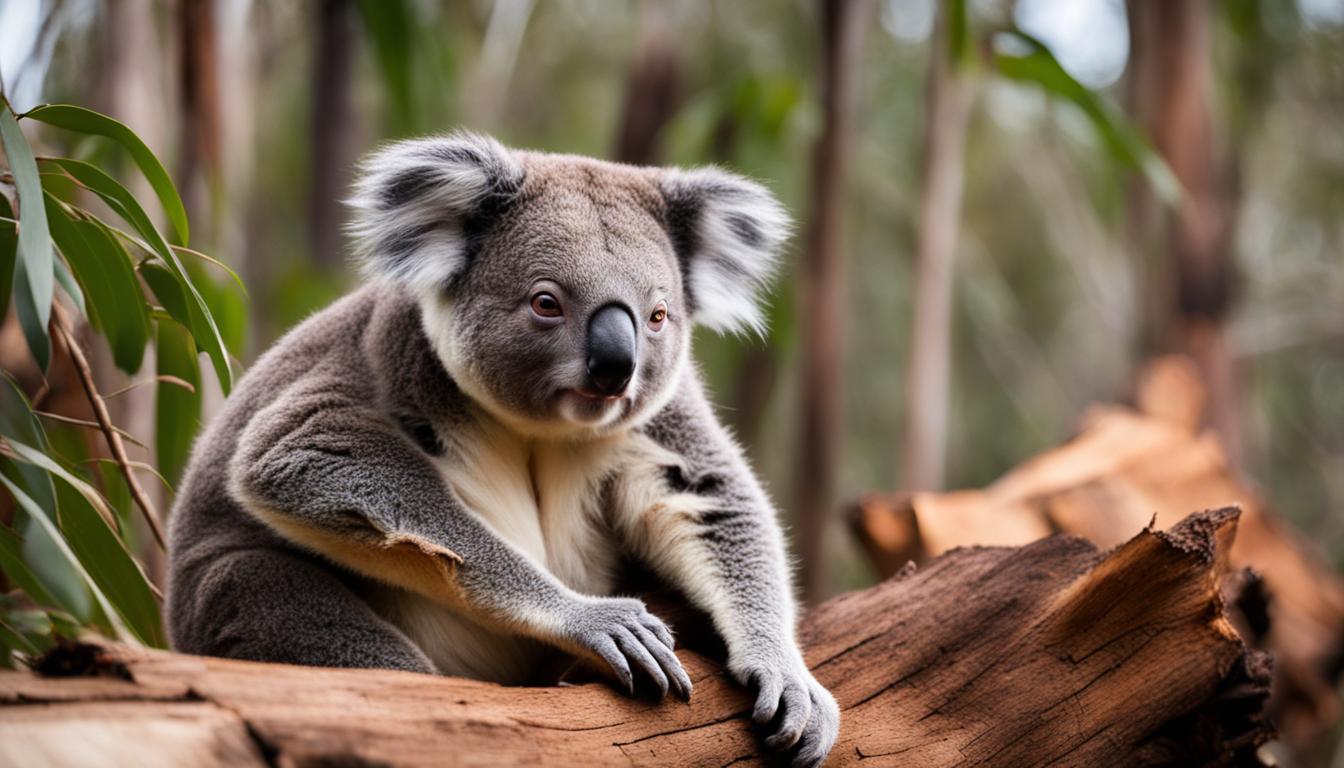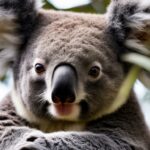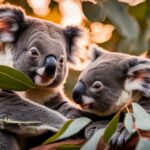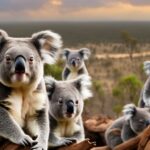Koalas are facing a critical threat to their survival due to habitat loss. The destruction of their natural habitat, caused by urban, industrial, and rural development, has had a devastating impact on wild koala populations in Queensland. This habitat loss has resulted in habitat fragmentation, making it increasingly difficult for koalas to find suitable food and shelter.
As a result, koalas are forced to venture into developed areas, putting them at higher risk of being hit by cars and attacked by dogs. The loss of their habitat also increases their stress levels, making them more vulnerable to diseases like Chlamydia.
Preserving koala habitats and implementing conservation efforts are crucial in addressing the impact of habitat destruction on koalas. By protecting their habitats, we can ensure the long-term survival of these iconic Australian animals.
The Impact of Habitat Destruction
The destruction of koala habitat has had a devastating impact on their population, leading to a significant decline in numbers. This loss of natural habitat has resulted in habitat fragmentation, making it increasingly challenging for koalas to find suitable food and shelter. As their habitats become smaller and more isolated, koalas struggle to move between areas, resulting in a decrease in gene flow and genetic diversity among populations. This lack of genetic diversity makes them less resilient to changing environmental conditions and more susceptible to the effects of inbreeding.
The fragmentation of koala habitat also exposes them to increased stress, diseases, and predation. With reduced access to food sources and shelter, koalas are more vulnerable to malnutrition and other health issues. This vulnerability is further exacerbated by the increased threat of car hits as koalas are forced to move through developed areas. The destruction of their habitat also brings koalas into closer proximity to domestic dogs, leading to a higher risk of dog attacks.
In summary, the impact of habitat destruction on koalas is vast. It results in population decline, reduced genetic diversity, increased vulnerability to diseases and predation, and a higher risk of car hits and dog attacks. Protecting and preserving koala habitats is crucial to ensure the survival of these iconic Australian animals for future generations.
Threats from Cars and Dogs
The destruction of koala habitats has resulted in the increased proximity of koalas to developed areas, exposing them to threats from cars and dogs. Each year, hundreds of koalas are killed by vehicle strikes as they are forced to cross roads more frequently due to habitat fragmentation. To mitigate this risk, it is crucial to prioritize protecting koala habitats and implementing measures to prevent further habitat loss.
Dog attacks pose another significant threat to koalas, with more than 100 koalas being hospitalized each year as a result of these encounters. To ensure the safety of koalas, it is important for community members to keep their dogs confined or restrained at night, especially in areas where koalas are known to reside.
Mitigating Koala Habitat Loss
To address the issue of koala habitat loss, various conservation efforts and habitat restoration projects have been initiated. These initiatives aim to protect existing koala habitats and restore degraded areas to provide additional food and shelter for koalas.
Protecting koala habitats is crucial in reducing the risks posed by cars and dogs to koala populations. By preserving their natural environment, we can create safer spaces for koalas to thrive and decrease their interactions with vehicles and dogs.
| Conservation Efforts | Description |
|---|---|
| Land Acquisition and Protection | Efforts to acquire and protect land for koala habitats, ensuring their long-term survival. |
| Habitat Restoration Projects | Restoring degraded habitats by replanting native trees, creating wildlife corridors, and enhancing the overall biodiversity of the area. |
| Community Engagement | Working with local communities to raise awareness about koala conservation and encourage individuals to take action in protecting their habitats. |
| Collaboration with Government Organizations | Partnering with government agencies to establish policies and regulations that prioritize koala habitat preservation. |
By implementing these measures and promoting sustainable practices, we can mitigate koala habitat loss and safeguard the future of these iconic Australian animals.
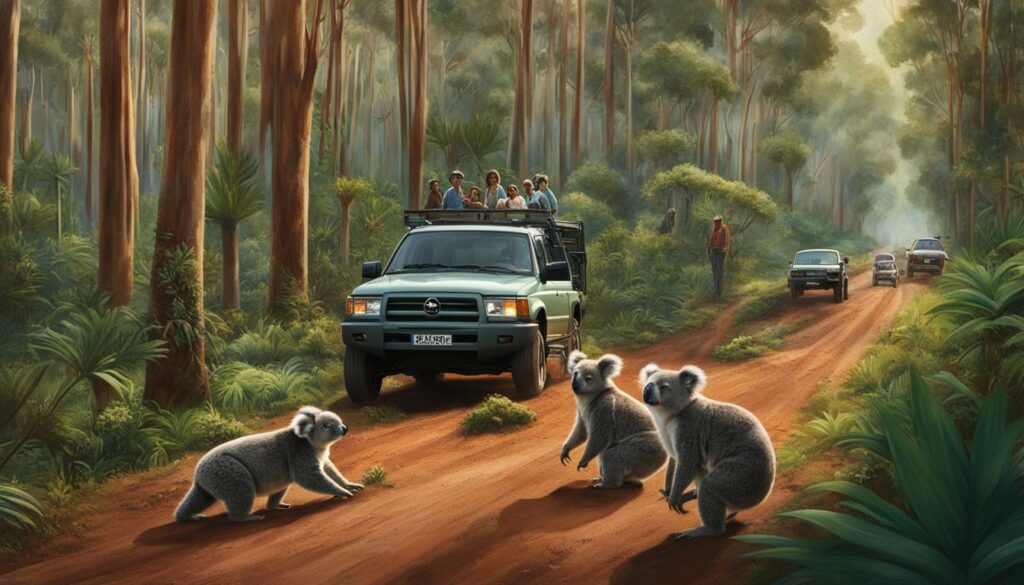
The Impact of Disease and Other Threats
Loss of habitat and increased stress have made koalas more susceptible to diseases, particularly Chlamydia. This bacterial infection affects almost all koalas in South East Queensland and weakens their immune system, leading to various health problems, including blindness and female infertility. In severe cases, it can even cause death. Other threats to koalas include the impacts of climate change, such as drought and bushfires, which have further contributed to habitat loss and population decline.
To address these threats, conservation efforts are essential to preserving koala habitats. Efforts include creating protected areas, restoring degraded habitats, and implementing management strategies to reduce the spread of diseases among koala populations. In addition, research and monitoring programs play a crucial role in understanding the impact of diseases on koalas and identifying effective conservation strategies.
Table: Koala Conservation Efforts
| Conservation Effort | Description |
|---|---|
| Habitat Protection | Establishing protected areas and wildlife corridors to preserve koala habitats and promote their movement between habitat patches. |
| Habitat Restoration | Implementing restoration projects to restore degraded habitats and provide food and shelter for koalas. |
| Disease Research | Conducting research to better understand koala diseases, develop treatment options, and prevent further spread. |
| Community Engagement | Engaging local communities in koala conservation efforts through education, awareness campaigns, and citizen science programs. |
The combination of these conservation efforts is crucial in addressing the root causes of koala population decline and ensuring their long-term survival. By protecting koala habitats, mitigating the impacts of disease, and addressing the challenges posed by climate change, we can work towards a sustainable future for these iconic Australian animals.
Protecting Koalas in Human-Impacted Areas
As urbanization continues to encroach on koala habitats, it is crucial to implement measures to protect koalas in human-impacted areas. By taking action, we can ensure the survival of these beloved marsupials for future generations. There are several ways individuals can contribute to koala conservation efforts and help protect koala habitats, even in suburbs and developed areas.
One important step is raising awareness among the public about the importance of koala conservation. By educating communities about the threats koalas face and the role they play in maintaining a healthy ecosystem, we can inspire action and support for their protection. Organizations and local councils can organize workshops, seminars, and informational campaigns to spread the message.
Another way to protect koalas in human-impacted areas is to make changes in our own behavior. Being cautious when driving in areas with known koala populations can make a significant difference. By adhering to speed limits and watching for wildlife crossing signs, we can minimize the risk of car strikes. Similarly, keeping dogs confined or restrained at night can prevent dog attacks on koalas, as they are most active during the evening and nighttime hours.
Creating Koala-Friendly Environments
Creating koala-friendly environments in suburbs and developed areas is also essential. This includes making fences koala-friendly to allow safe movement of koalas between properties. Installing koala gates or removing the bottom rungs of fences can provide easy access for koalas without compromising security. Additionally, planting native trees and shrubs in gardens can help provide additional food and shelter for koalas.
“Protecting koalas in human-impacted areas requires a collaborative effort between individuals, local councils, wildlife rescue services, and community members.”
Collaboration is key to protecting koalas in human-impacted areas. Local councils should work closely with wildlife rescue services to establish and implement effective koala conservation strategies. The engagement of community members through volunteering, reporting koala sightings, and participating in habitat restoration projects is also crucial. Together, we can make a difference and ensure the long-term survival of koalas in human-impacted areas.
| Ways to Protect Koalas in Human-Impacted Areas |
|---|
| 1. Raise awareness about koala conservation through workshops and campaigns |
| 2. Drive cautiously in areas with known koala populations |
| 3. Confine or restrain dogs at night to prevent dog attacks |
| 4. Make fences koala-friendly to allow safe movement |
| 5. Plant native trees and shrubs in gardens to provide additional food and shelter |
| 6. Collaborate with local councils, wildlife rescue services, and community members |
Conclusion
The decline of wild koala populations is a direct result of habitat loss and fragmentation. The destruction of their natural habitat has led to a decrease in koala numbers, making them more vulnerable to stress, disease, and predation. Additionally, threats from cars and dogs have increased as koalas are forced to navigate through developed areas.
Preserving and protecting koala habitats is crucial for their long-term survival. Conservation efforts must focus on mitigating further habitat loss, implementing habitat restoration projects, and raising awareness about the importance of koala conservation. Collaboration between individuals, communities, and government organizations is essential to address this urgent issue and reverse the population decline.
By taking action to protect koalas and their habitats, we can secure a sustainable future for these iconic Australian creatures. It is up to all of us to ensure that koalas continue to thrive and enchant future generations with their unique presence.
How does habitat loss directly contribute to the primary threats facing wild koala populations?
Habitat loss is a major factor in the threats to wild koalas. As their natural homes are destroyed for urban development and agriculture, koalas lose valuable food sources and are more vulnerable to predators. This directly contributes to the primary threats to wild koalas, such as disease and starvation.
FAQ
How does habitat loss impact wild koala populations?
Habitat loss is the biggest threat to wild koala populations. The significant clearing of land for development has resulted in the loss of much of the koala’s natural habitat, leading to habitat fragmentation, decreased availability of food and shelter, and increased vulnerability to threats like car hits and dog attacks.
What is the impact of habitat destruction on koalas?
Habitat destruction has led to a decline in koala population numbers. Habitat fragmentation makes it difficult for koalas to find suitable food and shelter, and it reduces gene flow and genetic diversity among populations, making them more susceptible to stress, disease, and predation.
How are koalas threatened by cars and dogs?
Habitat loss has brought koalas into closer proximity with developed areas, increasing the risk of vehicle strikes and dog attacks. Every year, hundreds of koalas are killed by car hits, and more than 100 koalas are hospitalized after being attacked by dogs. Protecting habitats and implementing measures to mitigate habitat loss are crucial in reducing these threats.
What other threats do koalas face?
Koalas are also threatened by diseases like Chlamydia, which weakens their immune system and leads to various health problems. Climate change impacts, such as drought and bushfires, further contribute to habitat loss and population decline.
How can we protect koalas in human-impacted areas?
Protecting koalas in human-impacted areas involves raising awareness about koala conservation and providing guidance on how individuals can help. This includes being cautious when driving to avoid hitting koalas, confining or restraining dogs at night to prevent attacks, and making fences koala-friendly to allow safe movement between properties.
What should be done to address the decline of koala populations?
Efforts to protect and preserve koala habitats, implement measures to mitigate habitat loss, and raise awareness about conservation are crucial. Collaboration between local councils, wildlife rescue services, and community members is essential in ensuring the long-term survival of koalas.

